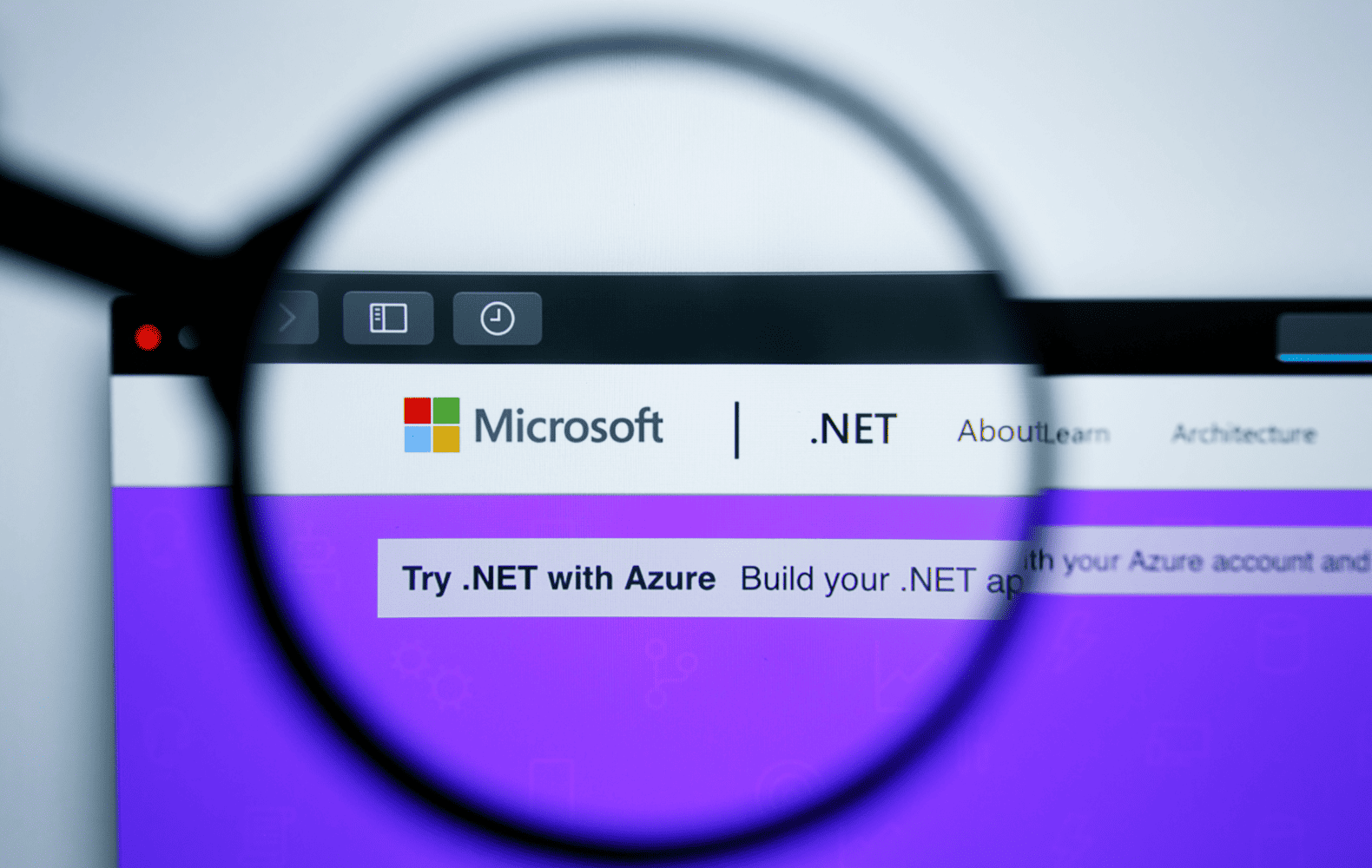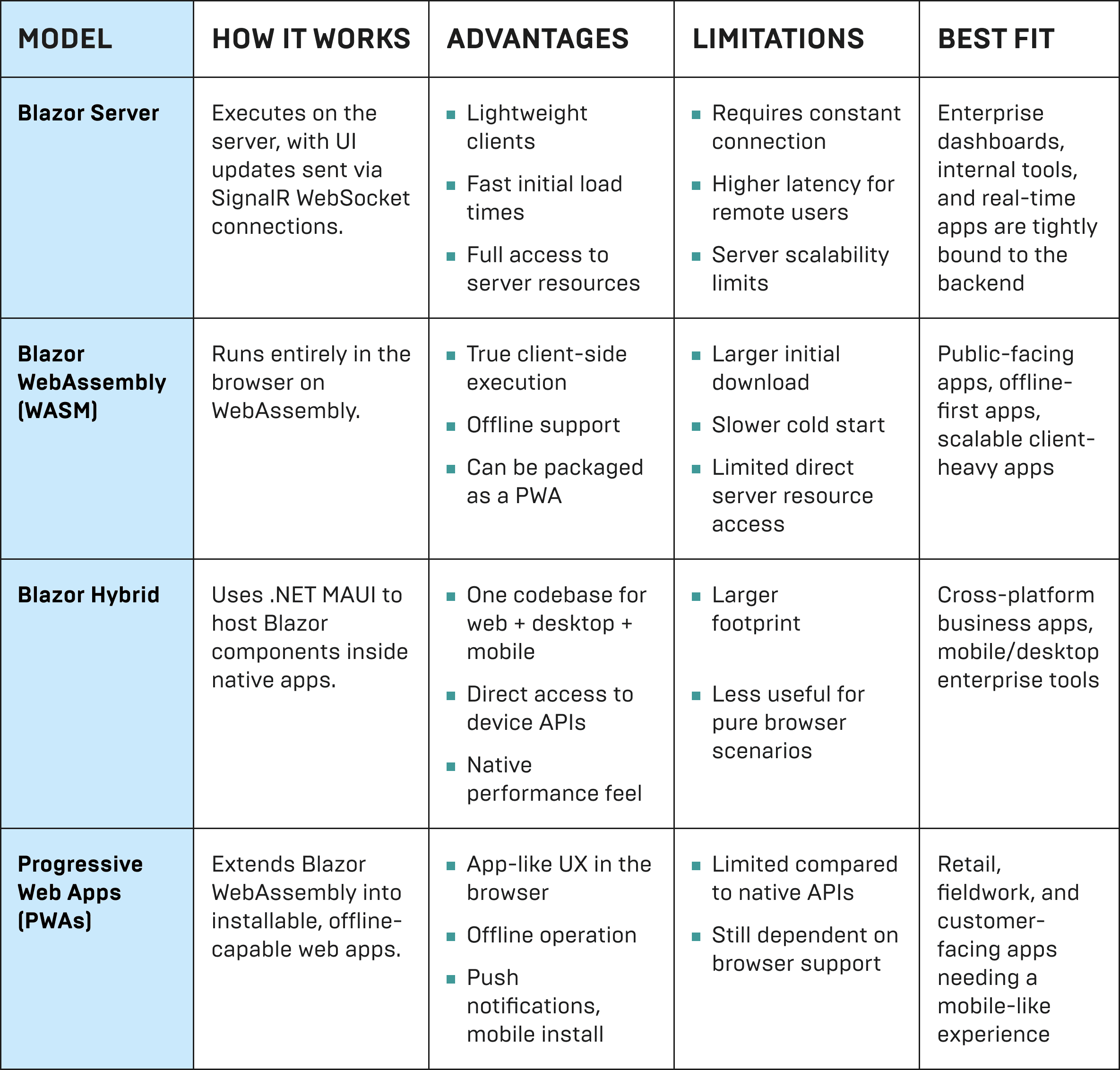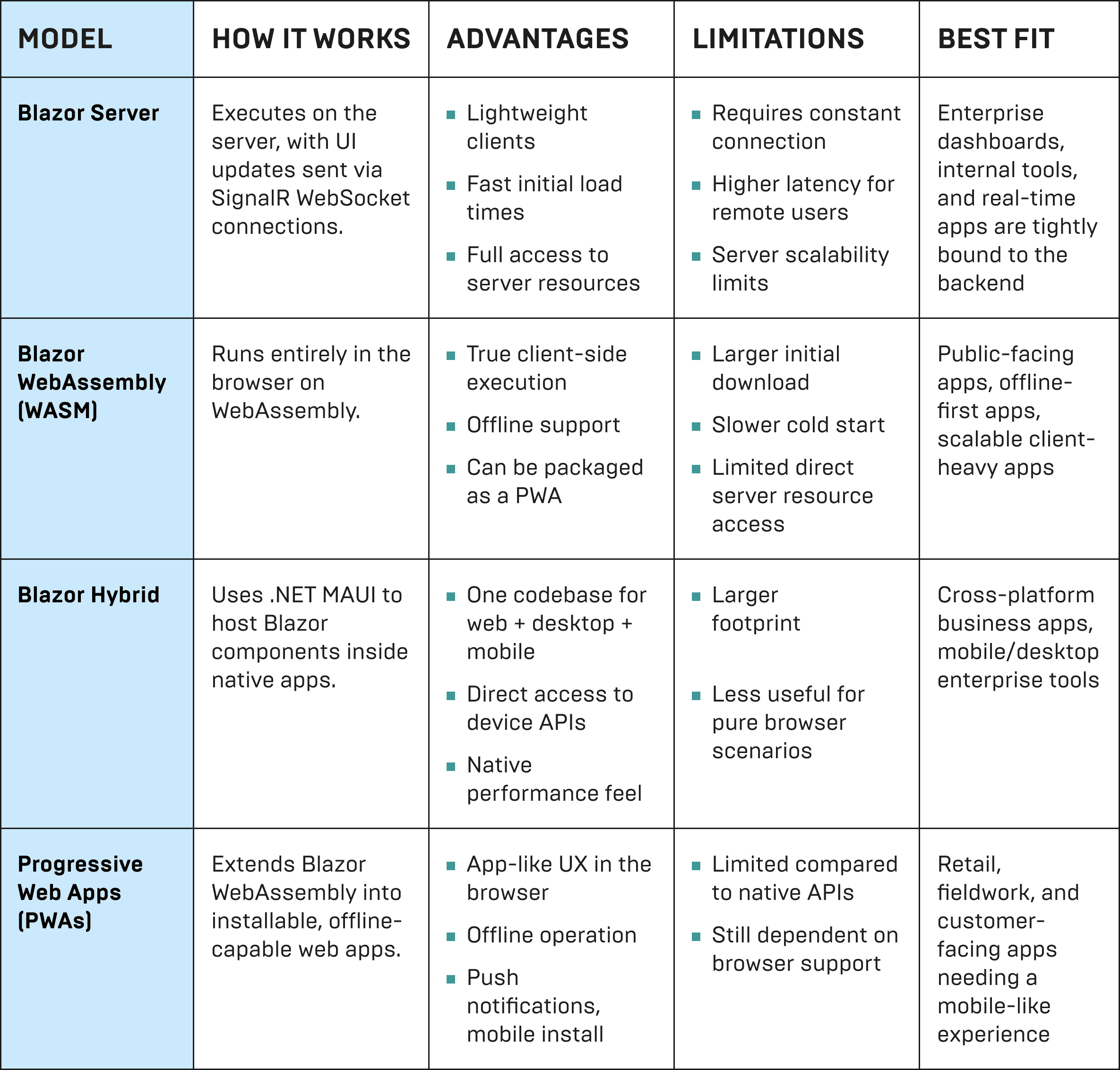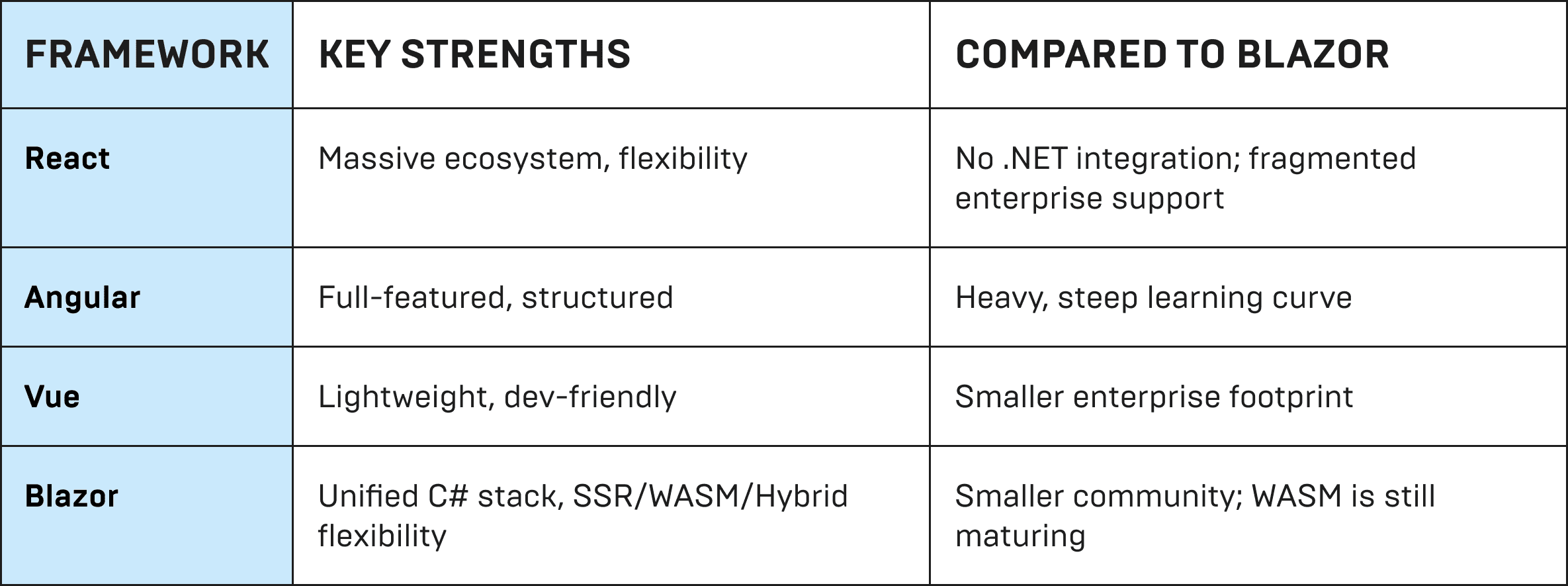The Future of Blazor: Trends, Use Cases, and What to Expect Beyond 2025
Few frameworks spark as much debate today as Blazor. Is it Microsoft’s bold answer to JavaScript dominance, or just another passing experiment? With .NET 8 and 9 solidifying Blazor’s foundation and Microsoft Build 2025 confirming its role as the future of .NET UI, the conversation has shifted. It’s no longer about whether Blazor will survive, but how far it can go, and what that means for enterprises choosing their next front-end strategy.
This article explores Blazor’s evolution, its real-world adoption, and Microsoft’s long-term plans. Read on to get a clear view of where the framework stands today and what to expect beyond 2025.
What is Blazor, and how has it evolved?
Blazor is Microsoft’s modern web UI framework that allows developers to build interactive, client-side applications using C# instead of JavaScript. Launched in 2018 as part of the ASP.NET Core family, Blazor emerged from the idea that .NET developers should be able to write full-stack web applications without needing to switch languages or frameworks.
Today, Blazor is actively developed on GitHub, where Microsoft engineers and the wider community contribute to its roadmap. Its growth is fueled by Microsoft’s continued investment and a rapidly expanding ecosystem of third-party components, development tools, and flexible hosting models that make it viable for enterprise-grade solutions.
C# in the browser without JavaScript
At its core, Blazor brought a breakthrough: running .NET assemblies directly in the browser through WebAssembly. This eliminated the need for JavaScript in many scenarios, allowing developers to share code between client and server smoothly. Instead of maintaining parallel logic in two languages, teams could use C# end-to-end, from data models to UI interactions.
While JavaScript remains dominant in the browser, Blazor’s approach addressed long-standing developer pain points: maintaining large TypeScript/JavaScript codebases, synchronizing contracts between front-end and back-end, and ensuring consistent business logic across layers.
For organizations with strong .NET expertise, this was a game-changer, enabling them to reuse talent, tooling (such as Visual Studio and VS Code), and libraries across the entire stack.
Hosting models
Blazor’s flexibility stems from its multiple hosting models, each designed to balance performance, connectivity, and platform reach in distinct ways. The table below highlights the trade-offs to help decision-makers align technology with business needs.
How Blazor fits into the ASP.NET Core ecosystem
Blazor is deeply integrated into ASP.NET Core. Developers can mix Blazor components with Razor Pages, MVC Razor views, and Web APIs, allowing incremental adoption rather than a complete rewrite. This interoperability has been critical to adoption, as enterprises rarely migrate entire systems overnight.
Moreover, Blazor complements ASP.NET Core’s strengths: hosting RESTful APIs, managing authentication/authorization, and connecting to modern databases. Together, they form a cohesive full-stack web development framework inside the .NET ecosystem.
Blazor’s rise in .NET 8 and 9
The release of .NET 8 (2023) marked a turning point: Microsoft officially positioned Blazor Server-Side Rendering (SSR) as a future-first investment. Enhancements such as streaming rendering, improved hot reload, and tighter integration with Razor Pages have made Blazor a more mature choice for production workloads.
With .NET 9 (2024), Blazor introduced features such as simplified component rendering, stronger tooling in Visual Studio, and performance improvements for Blazor WASM. These incremental but significant updates confirmed Microsoft’s commitment to making Blazor a long-term front-end solution, not just a niche experiment.
What .NET 10 means for the future of Blazor
Looking ahead, .NET 10 (expected in 2025) is widely anticipated to further unify Blazor with Microsoft’s broader web strategy. The focus areas include:
- Enhanced Blazor SSR for high-performance server-side rendering.
- Tighter integration with Progressive Web Apps (PWAs) and cross-platform development.
- Expanded tooling in Visual Studio and VS Code for component debugging and project scaffolding.
- Simplified pathways for enterprises migrating from JavaScript-heavy SPA frameworks like React or Angular.
In short, .NET 10 is expected to cement Blazor as Microsoft’s flagship web UI framework, making it a central piece of enterprise-grade, cross-platform, and cloud-integrated web development.
Why talk about the future of Blazor now?
Blazor has moved far beyond its early “experimental framework” phase. Today, it sits at the center of Microsoft’s web development strategy, shaping how the company envisions the next generation of cross-platform applications. But why is now the right moment to talk about Blazor’s future?
Microsoft’s strategic bet
At Microsoft Build 2025, the company highlighted its commitment to Blazor as the primary investment in .NET web UI. Key announcements positioned Blazor Server-Side Rendering (SSR) as a default approach for performance-critical applications, while also reinforcing support for Blazor WebAssembly and Hybrid models.
This clarity is significant, as it demonstrates that Microsoft is not only maintaining Blazor but also actively evolving it to compete with established JavaScript frameworks, such as React and Angular.
Shifts in web development
The broader web development landscape is also at a turning point:
- Server-Side Rendering (SSR) is resurging, offering faster first-load performance and SEO benefits compared to client-heavy SPAs. Blazor SSR integrates tightly with ASP.NET Core, giving enterprises a familiar yet modern path forward.
- Hybrid apps are blurring the line between web and native development. With Blazor Hybrid and .NET MAUI, teams can target desktop, mobile, and web browser development from a single C# codebase.
- Progressive Web Apps (PWAs) are maturing as viable alternatives to native mobile apps. Blazor WebAssembly provides an effective path to build installable, offline-capable applications without abandoning .NET.
The business case for looking ahead
Framework choices today define scalability, maintainability, and developer productivity for years to come. With .NET 8 already production-ready, .NET 9 improving the developer experience, and .NET 10 poised to enhance Blazor integration further, enterprises must assess whether Blazor provides them with a competitive advantage.
Instead of asking “Does Blazor have a future?” questions must now shift to: “How do we prepare for Microsoft’s Blazor future?”
Current use cases and adoption in 2025
Blazor’s popularity is evident in the diverse ways enterprises across industries. From automotive to finance and healthcare, organizations are choosing Blazor to deliver interactive, secure, and scalable front ends that integrate seamlessly with their .NET back ends.
Real-world use cases across industries
Here’s how leading organizations are putting Blazor to work:
- Automotive & luxury: Ferrari’s SFC Card Registration platform is built on Blazor, delivering an interactive user experience while simplifying its .NET ecosystem.
- Travel & infrastructure: Frankfurt Airport powers its real-time airport map with Blazor, improving traveler navigation through a responsive, C#-driven UI.
- Finance & forecasting: BurnRate relies on Blazor for revenue and headcount planning, leveraging the tight integration with existing .NET backends.
- Logistics & operations: Logistics firms run their internal dispatch dashboard on Blazor Server, ensuring smooth connectivity with .NET systems.
- Healthcare: Hospitals and clinics utilize Blazor for patient management platforms, utilizing its security, scalability, and compatibility with .NET infrastructure.
These examples show how Blazor is already in production across industries. The numbers back this up as well.
Rapid growth and adoption trends
Blazor’s footprint has expanded far beyond its experimental roots. According to BuiltWith, live deployments jumped from ~12,500 in November 2023 to nearly 40,000 in early 2025. As of mid-August 2025, that number has surged past 149,000 active sites, marking a tenfold increase in under two years.
This rapid rise reflects growing confidence among CTOs and enterprise architects who value a unified C# stack, smooth .NET integration, and productivity gains from shared codebases.”
Reenbit’s Blazor-powered case study: Glowi (Belgium)
One example of this adoption in action is Glowi, Belgium’s largest service company. Glowi needed a scalable way to manage work schedules and simplify communication, as its manual, resource-heavy processes were slowing growth.
To address this, the company partnered with Reenbit to build a Blazor + ASP.NET Core application integrated with their ERP system. The solution included scheduling, reporting, user management, leave requests, multilingual support, and document management with signing. It also featured SMS/WhatsApp notifications and was delivered as a PWA with offline mode to support staff in the field.
The results included:
- 86% employee adoption, exceeding expectations
- 75% daily active usage across the workforce
- Simplified back-office workflows and reduced workload
- Improved scheduling accuracy and task coordination efficiency
- A phased roadmap to expand from the cleaner app into a consultant portal and client-facing app
So, where does this leave decision-makers evaluating Blazor today? What should they consider when choosing a hosting model?
When and what type of Blazor to choose for your project
The right Blazor hosting model depends on your priorities: do you need fast server integration, offline support, or a single codebase across platforms? The table below summarizes where each option fits best.
The table above outlines where each Blazor hosting model is best suited. To show this in practice, here’s a case where a complex challenge was successfully solved with Blazor Server.
UK Contact Centre
A UK-based outsourced contact centre approached Reenbit to simplify agent workflows and modernize their call scripting process. Reenbit built a dynamic form automation system using ASP.NET Core, Blazor SSR, and Telerik UI. The solution included:
- Multi-page forms with conditional logic
- Contact database integration for call history and campaign grouping
- Twilio Flex integration for real-time script execution
- An admin panel for form creation and contact management
- Email workflows alongside voice calls
Results?
The platform gave the client a unified C# stack that reduced development time, streamlined script management, and enabled agents to handle complex, real-time form logic during calls.
Is it worth investing in Blazor now?
Blazor is no longer experimental, it’s a core part of Microsoft’s web strategy. With Blazor SSR positioned as the future of .NET UI at Build 2025, the framework now has enterprise-grade credibility. That’s because:
- Microsoft’s backing ensures long-term support.
- Mature tooling (Visual Studio, component libraries) makes development practical.
- Unified C# stack reduces context switching and hiring challenges.
- Proven adoption by companies like Ferrari and Frankfurt Airport, as well as enterprise projects at Reenbit, demonstrates its production readiness.
- Healthcare: Hospitals and clinics utilize Blazor for patient management platforms, utilizing its security, scalability, and compatibility with .NET infrastructure.
For teams already invested in .NET, Blazor is a low-risk, high-value choice in 2025.
Blazor vs other front-end frameworks
Blazor’s strength lies in its integration with .NET. Unlike React, Angular, or Vue, it doesn’t require parallel JavaScript expertise and integrates seamlessly with server-side systems.
For .NET shops, Blazor is a natural fit. For JavaScript-heavy teams, React or Angular still dominate. However, competition aside, let’s explore Blazor’s future.
What to expect from Blazor in 2025 and beyond
Blazor’s roadmap points to deeper integration and stronger performance:
- SSR upgrades: Faster rendering, SEO benefits.
- PWA improvements: Richer offline and installable apps.
- Tooling: Better debugging and hot reload in VS/VS Code.
- Hybrid growth: Tighter .NET MAUI integration.
- Ecosystem expansion: More third-party components and libraries.
With .NET 10, Blazor is set to become Microsoft’s flagship web UI framework. Early adopters will be positioned to take advantage of its evolution rather than play catch-up later.
Conclusion
Blazor is no longer an experiment, it’s a cornerstone of Microsoft’s .NET roadmap. With .NET 8 in production, .NET 9 improving performance, and .NET 10 set to unify hosting models further, enterprises now have a front-end framework built for scale, security, and longevity.
But turning that potential into business impact requires the right expertise. At Reenbit, a Blazor development company, we’ve helped organizations to modernize mission-critical systems and deliver measurable results. Drawing on that experience, we help enterprises decide where Blazor fits best, so it’s not just adopted, but integrated as a lasting strategic asset.
Ready to explore what Blazor can do for your business? Let’s connect!
FAQ
Is Blazor Gaining Popularity?
Yes. Blazor has grown rapidly, from ~12,500 sites in late 2023 to 149,000+ by mid-2025. Enterprises in sectors like automotive, finance, and healthcare are adopting it for its unified C# stack and Microsoft’s backing.
Is Blazor a Temporary Trend or a Long-Term Solution?
Blazor is a long-term solution. Microsoft has made it central to .NET UI strategy, expanding it in .NET 8, 9, and the upcoming .NET 10. Its roadmap and enterprise adoption confirm it’s here to stay.
How Does Blazor Fit Into Microsoft’s .NET and MAUI Strategy?
Blazor integrates with ASP.NET Core for web APIs, Razor Pages, and MVC, while .NET MAUI lets developers use Blazor components across web, desktop, and mobile from one C# codebase.
Could Blazor Become a Full Alternative to React or Angular?
For .NET teams, Blazor already rivals them. Its ecosystem is smaller, but with multiple hosting models (SSR, WASM, Hybrid, PWA) and strong .NET integration, it’s positioned to become a credible alternative as adoption grows.




